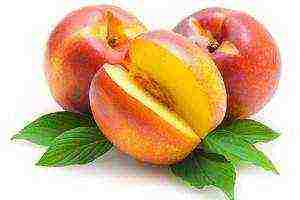Content
Beetroot is one of the oldest vegetable crops that people grew 2 thousand years ago. Due to its unique ability to acclimatize and ease of maintenance, it can be cultivated in regions with warm and cold climates. More than 70 varieties of this vegetable are known to modern breeders and gardeners, which differ in external characteristics, ripening times and yield.
Choosing the best varieties of beets
Beets can range in color from raspberry to deep purple. It is believed that the most useful and tasty fruits are of intense color without pronounced light rings. It should be noted that such a statement can hardly be called a serious delusion, since a bright
beet color is due to the high concentration of anthocyanins - these are natural antioxidants, which also have antiseptic and vaso-strengthening properties.
Beets can be of different shapes, sizes and shades.
The color and taste of the fruit depend on several factors, but the characteristics of a particular variety play the main role in this case. So, what varieties of this extremely useful vegetable are considered the most useful, tasty, and most suitable for planting in a personal plot?
Early maturing varieties
|
One-sprout |
80-130 | 300-600 | Round or slightly flattened fruits of a bright maroon hue, tender and very juicy flesh | An early ripeness variety that usually begins the beet season. It gives a fairly large harvest, and has one valuable feature - the presence of only one sprout in the glomerulus, so that the planting does not have to be thinned out |
|
Improved Red Orb |
72-78 | 150-250 | As the name implies, the fruits of the Red Ball are aligned and round, the pulp tastes very delicate, and has excellent tasting characteristics. | The fruits contain many beneficial substances and are often used for medicinal purposes. Other advantages include the simultaneous ripening of the crop and excellent preservation of root crops in the cold season. |
|
Winter |
55 | 200-300 | Rounded, juicy roots of intense dark red color. There are no cross rings on the cut | The variety is especially recommended for winter planting. Under favorable conditions and proper care, the yield of "Podzimney" can be significantly higher than that of other early-maturing varieties. In addition, such an unpleasant phenomenon as flowering is not typical for her. |
|
Boltardi |
100-110 | 150-350 | Smooth, medium-sized fruits that have a smooth skin and a uniform dark cherry flesh without ringing (sometimes, ringiness may be mild) | Due to its excellent commercial characteristics, this variety is especially common in small farms that grow vegetables for sale. Has good plasticity, resistance to the appearance of arrows. Root vegetables are versatile, meaning they can be eaten fresh, canned or stored |
|
Egyptian flat |
110-130 | 300-500 | Small oval, slightly flattened fruits with a uniform, reddish-purple surface color.The pulp with a slight shade of pink has no transverse ringiness, and is distinguished by tenderness, juiciness and good taste. | Plantings of this variety give a large yield, are not subject to flowering. The fruits are well suited for consumption in the autumn-winter period, as they can be stored for a long time. |
|
Libero |
80 | 125-225 | The fruits have a very attractive appearance: round, smooth and aligned, with a thin root, colored inside and outside in a bright dark red color. The pulp is firm, with little or no annularity | The variety is moderately resistant to the appearance of arrows, gives a large yield, but when growing it should be remembered that it is quite picky about soil moisture |
Mid-season varieties
|
Bohemia |
70-80 | 300-500 | Fruits are round or slightly flattened in shape. Inside, juicy, tender maroon pulp, without transverse rings, with a pleasant, sweetish taste | The variety belongs to those that are especially recommended for cultivation in gardens and summer cottages. It is unpretentious in care, does not require thinning, is not susceptible to blooming and diseases characteristic of beets, and besides, it is very well stored in winter. It is recommended to grow "Bohemia" on fertile soils with neutral acidity - in this case, it gives a particularly rich harvest |
|
Bordeaux |
62-116 | 230-510 | Rounded or slightly flattened with intense coloration and firm, tender, dark red sugary flesh | One of the most widespread varieties of beet, which has been cultivated in Russia for over a century. The main advantage is that it can grow and yield good yields in almost any conditions. The pulp is distinguished by a high concentration of sugars and anthocyanins, due to which the beets of this variety are considered almost the most useful. Stores well in winter and is suitable for all types of processing. Plants are unpretentious to care for, and their fruits are immersed in the ground by about half, that is, harvesting is greatly simplified |
|
Detroit |
100-110 | up to 250 | Smooth, round, uniform size fruits with a smooth surface and a small rosette of leaves. The color of the flesh is red, rich, without transverse rings on the cut | The main advantages include high yield, resistance to shooting, unpretentiousness to growing conditions and excellent keeping quality during storage. |
|
Larka |
100-120 | 150-300 | Small round fruits with a neat rosette of leaves and an intense dark red surface. The pulp does not have transverse cut rings (in some cases they are poorly expressed) and has an excellent taste | A variety, bred in Holland, which is highly resistant to the appearance of flowers and many diseases. Suitable for harvesting using agricultural machinery, well suited for fresh consumption, as well as for processing and storage. Separately, it should be noted that the use of this variety of beets promotes the removal of radionuclides from the human body. |
|
Bona |
120 | 250-280 | Beautiful, rounded fruits of deep red color with a soft head, the surface is smooth. They taste juicy, tender, without ringiness on the cuts, with excellent tasting qualities. | Beetroot varieties "Bona" are ideal for use in cooking (both fresh and processed) and canning. The variety is highly valued among farmers and gardeners for its high yield and good keeping quality. |
|
Mulatto |
120-130 | up to 350 | Root crops are round, even, with a smooth skin closer to maroon color. The rosette of leaves is small, standing, the pulp is of a bright color that does not fade even during cooking | One of the recently bred varieties, which is easy to care for and gives a good harvest. In winter it is stored without loss of flavor characteristics |
|
Incomparable А463 |
69-100 | 170-390 | Rounded or flattened fruits, the surface is dark red, slightly burgundy, slightly grayish at the head. | A kind of "Bordeaux" variety, which many gardeners call the best in taste of all domestic.In addition, it is the leader in the content of a beneficial substance called betaine. The variety is relatively resistant to most diseases, but its keeping quality is average - over time, the fruits begin to deteriorate |
|
Pablo F1 |
78 | 109-180 | Rounded, attractive-looking fruits with a thin skin have an intense red flesh without transverse ringing | Extremely hardy, frost-resistant, non-flowering variety, which is recommended for cultivation in unfavorable climatic conditions. Virtually unaffected by diseases and pests |
Why beets sometimes go into bloom
Late-ripening varieties
|
Cylinder |
110-130 | 180-350 | Fruits have an oblong shape, unusual for beets, length - 10-16 cm. The pulp is very juicy, sugary, with an increased concentration of iron, calcium and vitamins does not have a characteristic "beet" flavor | The variety is resistant to most diseases, and it is very easy to harvest such beets, as they grow above the soil surface. "Cylinder" is widely used in cooking, not only because of its taste, but also because its fruits are cooked very quickly. The variety is also well suited for storage - in a cool place, beets can survive the winter without loss. |
|
Renova |
100-110 | 180-350 | Smooth, dark pink cylindrical fruits. The pulp tastes very juicy, dense and tender, without pronounced ringiness | The variety gives a high yield of fruits with excellent keeping quality (they can be stored for at least six months without losing taste) |
How to grow delicious beets?
It should be noted that the color and taste of root crops depends not only on the variety, but also on the conditions of "life" and planting care. In order for the roots to be tasty and have a bright, beautiful color, the gardener needs to remember several important rules.
- At elevated temperatures or after prolonged drought, the intensity of the color of the fruit decreases, and white fibrous rings appear on the cuts. In addition, the beet pulp becomes rough and tasteless.
- Excess moisture is no less harmful to plantings than its prolonged absence. In this case, the root vegetables become excessively large, acquire a watery taste, and voids form inside, which makes the beets unsuitable for storage.
Recommendations for watering beets
- Beets should not be planted immediately after applying organic fertilizers to the soil, otherwise the fruits will taste bitter.
- Do not shade the plantings too much, as this reduces the content of sugar and dry matter in the pulp, on which the taste of beets depends.
Why beets are bitter and how to prevent it
With proper and timely care, any variety of beets will provide the gardener and his family with healthy roots, from which many delicious dishes can be prepared.
Video - How to grow beets healthy and tasty
Sugar beet varieties and hybrids differ in many ways. But among them there are absolute leaders, bred as a result of many years of selection. Now you will learn about nine of the best beet varieties based on a combination of traits.
First of all, table beets should be tasty, safe for health and have a long shelf life. Many gardeners believe that the whole set of these qualities can only be found in varieties of foreign selection. Indeed - imported root crops are smooth and beautiful, consistently pleasing with a high yield. But even among the domestic varieties, you can find sweet and spicy varieties. We will tell you about the best of the best representatives of the beetroot world.
Bordeaux 237
This variety was bred by Soviet breeders in 1943. This is one of the most popular and studied mid-season varieties. The plant is thermophilic and demanding on lighting, but at the same time it is distinguished by drought resistance. Root crops are round and flat-rounded, with delicate flesh of a thick burgundy color. The sugar content is high, while the beets are stored for a long time without losing their taste. The variety is resistant to diseases, occasionally affected by cercosporosis and peronosporosis.
| Appointment | Root diameter (cm) | Beet weight (g) | The period from germination to technical ripeness (days) |
Yield (kg / sq.m) |
|
|
12-15 |
260-500 |
60-110 |
4-8 |
||
Bravo
One of the most productive, unpretentious, tasty and mature varieties. It can be grown all over the area from Moldova to the Ural Mountains. Root crops are round, smooth, dark red, with a small head. The pulp is light burgundy, without ringiness, dense and juicy. Up to 98% of the sown seeds emerge. A plant below average is affected by cercospora and beet flea.
| Appointment | Root diameter (cm) | Beet weight (g) | The period from germination to technical ripeness (days) |
Yield (kg / sq.m) |
|
|
13-16 |
250-680 |
70-100 |
3-7 |
||
Valenta
Mid-season high-yielding variety. The roots are dark red, smooth and clean. The pulp is juicy and tender, with faint rings. A ripe root crop is easily pulled out of the soil. The taste is memorable, dessert. Beets contain a large amount of B and PP vitamins. The plant withstands extreme cold, but responds to lower temperatures by lowering yields. The harvested crop can be stored for a long time without fear of loss of presentation.
| Appointment | Root diameter (cm) | Beet weight (g) | The period from germination to technical ripeness (days) |
Yield (kg / sq.m) |
|
|
12-15 |
175-330 |
90-120 |
4-8 |
||
Mona
Medium early single-sprout variety. Root crops are cylindrical, red in color with a dark color. The pulp is dark red, juicy and melts in the mouth. The plant does not need additional thinning during the growing period. Water the roots as needed, slightly increasing the frequency of watering during dry periods. Regular feeding and loosening should be carried out and then the plant will not be afraid of diseases.
| Appointment | Root diameter (cm) | Beet weight (g) | The period from germination to technical ripeness (days) |
Yield (kg / sq.m) |
|
|
10-13 |
200-330 |
75-100 |
5,5-7 |
||
Mulatto
Outwardly, this variety does not differ much from the usual table varieties of beets. Root crops are of the correct round shape, as they ripen, they change color to maroon. Gardeners appreciate the pulp for its amazing taste and the absence of rings. The yield of the variety is quite high and practically does not require additional care. Mulatto is best stored during the winter months, and the marketable yield is usually 95-98%.
| Appointment | Root diameter (cm) | Beet weight (g) | The period from germination to technical ripeness (days) |
Yield (kg / sq.m) |
|
|
10-12 |
180-360 |
125-130 |
3,5-6 |
||
Incomparable А463
It is a rare case when the properties of a product fully correspond to its name - this is really one of the best varieties. Root crops are usually flat, sometimes round-flat with a maroon skin, which turns gray closer to the outlet. Beets have a delicate flesh with a dark scarlet hue and dark rings. The variety is absolutely resistant to cercosporosis and keeps well for several months. Great for all types of home cooking.
| Appointment | Root diameter (cm) | Beet weight (g) | The period from germination to technical ripeness (days) |
Yield (kg / sq.m) |
|
|
8-10 |
170-360 |
70-100 |
3-6 |
||
Pablo F1
This hybrid was obtained relatively recently, but has already managed to fall in love with many gardeners for its useful properties and unpretentiousness. Medium early in terms of ripening, it has an unsurpassed yield, which reaches 98-99%. All root vegetables are like siblings - they are very similar to each other, with thin skin and a small tail. The flesh on the cut is bright red, without annular divisions. Plants thrive in cold regions and can be stored throughout the winter.
| Appointment | Root diameter (cm) | Beet weight (g) | The period from germination to technical ripeness (days) |
Yield (kg / sq.m) |
|
|
10-15 |
125-450 |
60-100 |
6-7 |
||
Rocket F1
The elongated roots of this hybrid are difficult to confuse with others. It belongs to the mid-season and is used both for processing and for haute cuisine. Root crops are cylindrical, dark red, with a smooth, almost glossy surface. The color is intense and uniform. The color of the flesh approaches purple, the rings are absent.The taste is excellent. The yield and keeping quality of root crops is high.
| Appointment | Root diameter (cm) | Beet weight (g) | The period from germination to technical ripeness (days) |
Yield (kg / sq.m) |
|
|
3-5 |
250-400 |
120-125 |
5-7 |
||
Cylinder
The unusual shape of the root crop, characteristic of this variety, attracts gardeners very much. These are medium-sized plants with dark red oblong fruits and a small "waist". The variety is weakly susceptible to various kinds of diseases, therefore, yields are high. The sweet taste allows you to add beets to borsch, salads and use for preservation. There are no whitish circles in the root crop, so it is very convenient to cut the beets and add them to various dishes.
| Appointment | Root diameter (cm) | Beet weight (g) | The period from germination to technical ripeness (days) |
Yield (kg / sq.m) |
|
|
4-5 |
250-500 |
110-130 |
5-7 |
||
Sweet beets are a real decoration for any table. With her, dishes acquire a completely new taste and emphasize the skill of the chef. Anyone can grow such beets, especially if you grow one of the varieties we have described.
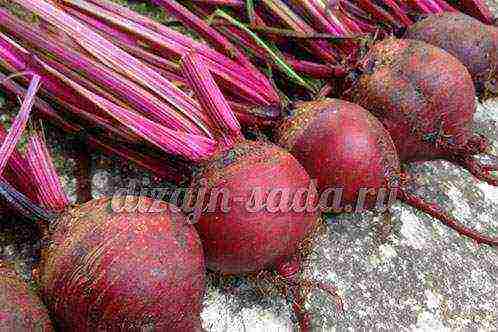
According to the ripening period, beets are divided into early, mid-ripening and late. For winter storage, the second and third are suitable. Early and ultra-early beets are good because they ripen in 2-3 months, but they do not lie well.
Using personal experience, reviews of gardeners from the forum and neighbors in the country, I will describe the best yielding varieties of beets.
The best early varieties of beets, descriptions, reviews
Egyptian flat beet
Early maturing (from germination to harvesting 95-115 days) beet variety. Root crops are flat-round, dark red, weighing 200-400 g. The flesh is red with a violet tinge, juicy, good taste.
Advantages of the variety: stable yield, resistance to drought and flowering, suitability for long-term storage.
Egyptian flat sekla is suitable for all types of culinary processing.
Beet yield Egyptian flat: 5 - 8.3 kg per sq.m.
Beetroot Red ball improved
Ultra-early (72-78 days from germination to harvest) high-yield beet variety. Root crops are even, rounded, weighing 150-250 g. Their flesh is dark red, tender, juicy, sweet, almost without rings, quickly cooked.
Advantages of the variety: amicable yield of the harvest, high commercial qualities, good keeping quality. Recommended for home cooking, as well as baby and diet food.
Beet yield red ball: 3 - 6 kg from 1 sq.m.
Bordeaux beet 237
Medium early variety (period from full germination to technical ripeness 95-110 days). Root crops are round, weighing 200-500 g, with dark red pulp and excellent taste.
Advantages of the variety: comparative heat resistance, high yield in all weather conditions, good keeping quality during winter storage. Recommended for cooking and processing. Due to the rapid overgrowth of root crops, later and thickened crops are recommended.
Beet yield Bordeaux 237: 4 - 8 kg from 1 sq.m.
Cold-resistant beets 19
A mid-early variety of beets, the period from full sprouting to technical ripeness is 66-76 days. Root crops are flat-rounded, dark red, smooth, weighing 150-220 g. The pulp is juicy, tender, with excellent taste.
The variety is suitable for growing on a bunch with podwinter and early spring sowing. Used fresh, for processing and long-term storage.
Advantages of the variety: cold resistance, suitability for winter sowing, resistance to flowering, good keeping quality.
Beet yield Cold-resistant 19: 4-7 kg from 1 sq.m.
Mid-season beet varieties, description, photo
Beetroot bohemia
A mid-season variety (70-80 days pass from the moment of germination to ripening) of table beet. Root crops are rounded and flat-rounded, with a maroon color. The pulp is maroon, juicy and tender, without rings, with excellent taste. The weight of one fruit is 300-500 g.
Advantages of the Bohemian variety: resistance to cercosporosis and flowering, does not require thinning, good keeping quality.
Beet yield Bohemia - up to 4.8 kg from 1 sq.m.
Bona beet
High-yielding mid-season beet variety (period from germination to harvesting 115-120 days). Root crops are round, large, aligned, smooth, dark red. The pulp is evenly colored, without rings, has excellent taste.
Advantages of the variety: large root crops have high commercial qualities and good keeping quality.
Beet yield of Bona: 5.5 - 6.8 kg per sq.m.
Detroit beet
The most common mid-season beet variety (100-110 days pass from germination to ripening). Root crops of the correct, rounded shape, the same size, with a smooth skin, deep red color, without rings. The weight of the roots is about 250 g. The rosette of leaves is not dense.
Advantages of the variety: resistance to shooting, high yield, even fruits with good marketable qualities, excellent keeping quality. Suitable for both long-term storage and processing.
Beet yield Detroit: 3.6 - 6.9 kg per sq. m.
Beet Incomparable A 463
Medium-early high-yielding, cold-resistant beet variety, 70-100 days pass from germination to harvest. Root crops are rounded and flat-rounded, weighing 170-400 g, dark red with a burgundy tint.
Advantages of the variety: cold-resistant, resistant to flowering and cercosporosis. Possesses good keeping quality.
Beet yield Incomparable А 463: 2.9 - 7.0 kg from 1 sq.m.
Agricultural technology: sowing May 1-15, sowing pattern 30 x 7 cm, harvesting July 25 - September 5.
Beet mulatto
New mid-season variety (from germination to harvesting 120-130 days).
Root crops are rounded, leveled, smooth, maroon color, weighing 150-350 g. The pulp is red, without rings, juicy, tender, with excellent taste. Preserves color when heat treated. Ideal for winter storage.
Sowing with seeds in the ground in late April - early May to a depth of 2-4 cm, with row spacing of 25-30 cm and a distance between seeds of 7-8 cm.
Beet yield Mulatto: 2.5-4.4 kg from 1 sq.m.
The best late varieties of beets, description, photo
Renova beet
Late-ripening, high-yielding variety with long cylindrical dark pink roots. From mass shoots to technical ripeness, 100-110 days pass.
Root crops are leveled, weighing 180-350 g, with dark purple juicy, tender, dense pulp, without rings.
Advantages of the variety: good keeping quality for 6-7 months, while not losing taste.
Renova beet yield: 7-9 kg from 1 sq.m.
Beet Cylinder
Medium late (120-130 days) beet variety. Root crops are cylindrical, 5-9 cm in diameter and 10-16 cm long, weighing 180-250 g, with a thin skin. The pulp is juicy, sweet, dark red, without rings.
The Cylinder variety is distinguished by good keeping quality and resistance to the main diseases of beet. Possesses excellent taste.
Cylinder beet yield: 7-10 kg from 1 sq.m.
Beets prefer fertile sandy loam soils. Seeds are sown in the ground in the second half of May. The seeding depth is 2-4 cm, the distance between the rows is 30 cm, between the seeds is 7-8 cm.
Beets are responsive to potash and ash fertilization. During the entire growing season, loosening of row spacings, weeding, thinning of seedlings is carried out. Beets are watered depending on weather conditions; they do not tolerate waterlogging.
For winter sowing, seeds are sown at the end of October to a depth of 4-6 cm.
The best precursors for beets are early potatoes, onions, cucumber, pumpkin, and squash.
We recommend purchasing beet seeds of excellent quality in the Sady Rossii online store.
The concept of "the best varieties of beets" is very arbitrary. It is important for someone that there are no white rings; someone - to be kept for a long time; the third loves cylindrical beets, the fourth wants to grow a sweet root vegetable. Fortunately, hybrids and varieties of canteen beets delight in variety and are able to satisfy the tastes of almost any gardener.
Therefore, we propose to divide the varieties of table beets according to the most important classifications, so that it is easier for you to choose the appropriate variety (by size, shape, ripening time, etc.)
Beet varieties in terms of ripening are:
— early maturing... The fruits of early ripening varieties ripen in about two months: planted in May, and at the end of July you can already harvest the first crop! But the only problem is that such a root crop is stored quite badly, so it is not worth much to plant early varieties of beets. The best varieties of canteen beets from the early - Detroit, Egyptian Flat, Bona, Red Ball, Mulatto, Bovine Blood, Cold Resistant 19.
- mid-season... The best option for gardeners living in the Middle Lane is the cultivation of mid-ripening beets (ripening periods - 80-100 days). Such beets are stored quite well, and have excellent yields, and their taste is more remarkable than that of the early beets. The best varieties of mid-season beets: Bordeaux 237, One-sprout, Incomparable, Cylinder, Winter, Pablo
— late ripening. Late-ripening varieties (ripening period - 100-135 days) are best suited for long-term storage. But their main drawback is that in the Middle Lane they do not have time to mature normally, therefore, late varieties of beets are planted only in more southern regions.
Table beets, depending on the shape, are:
- flattened (Egyptian flat, Incomparable, Nosovskaya flat, Bona)
- cylindrical (varieties of the Cylinder, Mona, Ataman, Torpedo)
- rounded (varieties Pablo, Mulatka, Detroit, Bordeaux 237, Red ball, Boltardi, Darkie, Kestrel)
What are the best beetroot varieties to store?
Best stored beets of Bordeaux 237, Podzimnyaya, Incomparable, hybrid Pablo F1, Nosovskaya flat.
Which beet varieties are suitable for winter sowing?
It is best to use beets of the Cold-resistant 19 and Podzimnyaya varieties for podzimnyaya sowing.
What are the sweetest varieties of beets?
Cylinder (most varieties of cylindrical beets are characterized by a high content of sugars), Mulatto, Red Ball, Detroit, Incomparable, Darkie, Kestrel,
The best beetroot varieties without light rings:
Pablo F1, Cylinder, Detroit, Boltardi, Kestrel
Characteristics of beet varieties with photos and descriptions
And now we bring to your attention a description of the varieties of red beets - the most popular, most productive and in demand today.
Beet Pablo F1
The most popular beetroot today is a hybrid of the Dutch selection Pablo F1. Its secret is in the optimal combination of a small shape, almost complete absence of white rings, sweet taste with unpretentious cultivation. It belongs to the medium early, it is resistant to adverse weather conditions (cold, moisture deficit) and, which is very important, to the quality of the soil. Therefore, it can be grown in Ukraine, and in Belarus, and in Moldova, and in the northern regions of Russia. Thus, Pablo F1 is one of the best beet varieties for the Urals.
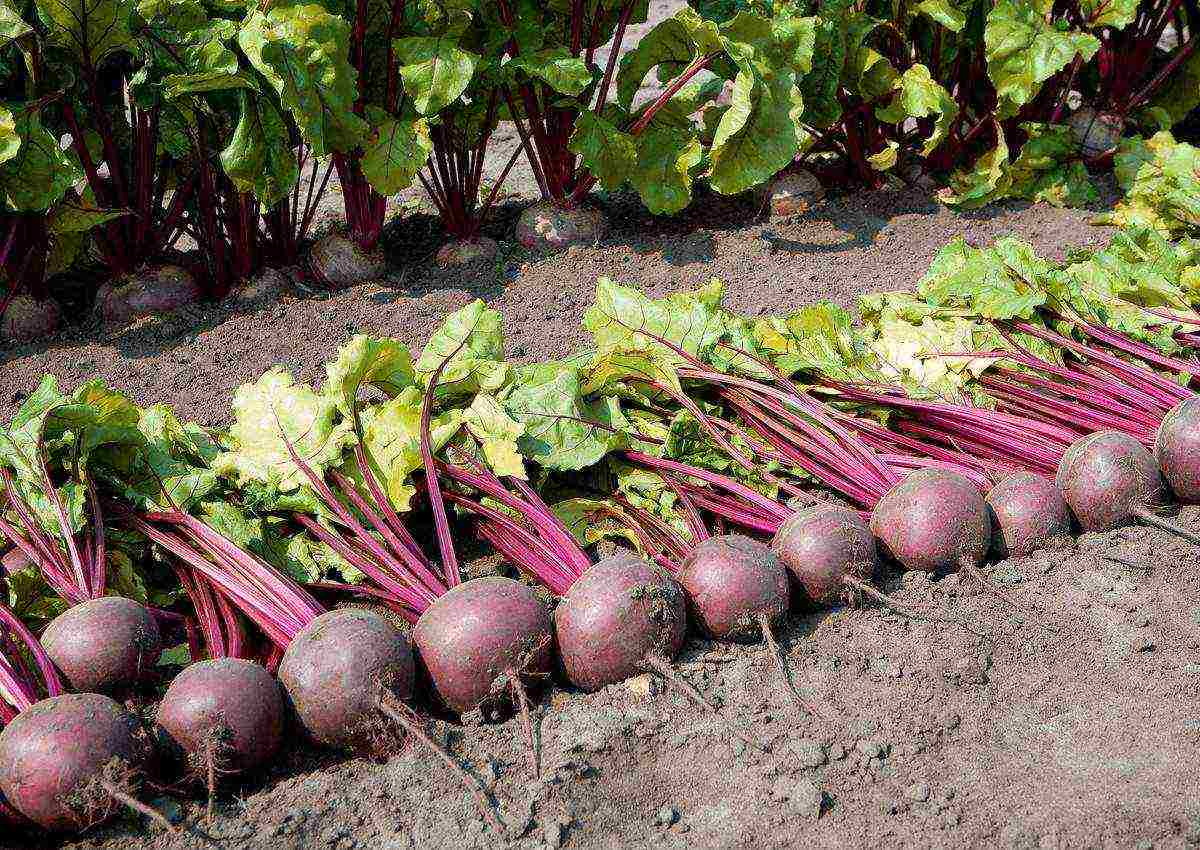
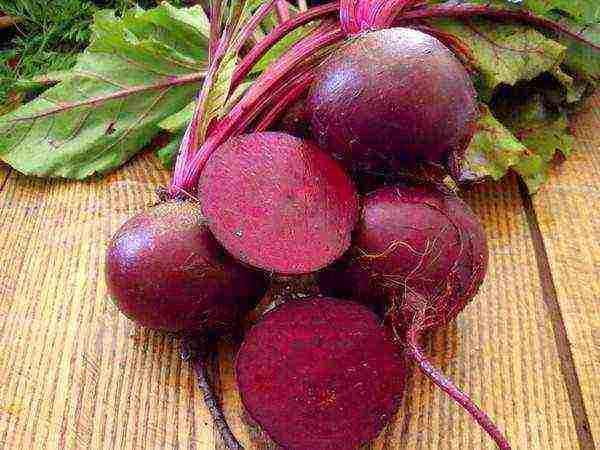
The root crop is stored without losing its shape and taste for several months, it is not prone to cracking, shooting and flowering, it is resistant to many dangerous diseases (scab, cercospora, corneed). Pablo F1 beets have a straight, medium-sized rosette, round-shaped fruits, weighing 100-150 grams (sometimes up to 200-250 grams), 10-15 cm in diameter, average yield - up to 7 kg per "square". The color of the pulp is burgundy-purple, the skin of the root crops is burgundy, smooth, rather thin. The growing season is 100-110 days.
Beet Cylinder
Another very popular, time-testedbeet variety - Cylinder... Gardeners fell in love with it for a rather long shelf life (more than 4 months), sweet juicy pulp without the notorious rings, very tasty, as well as resistance to major diseases of root crops.
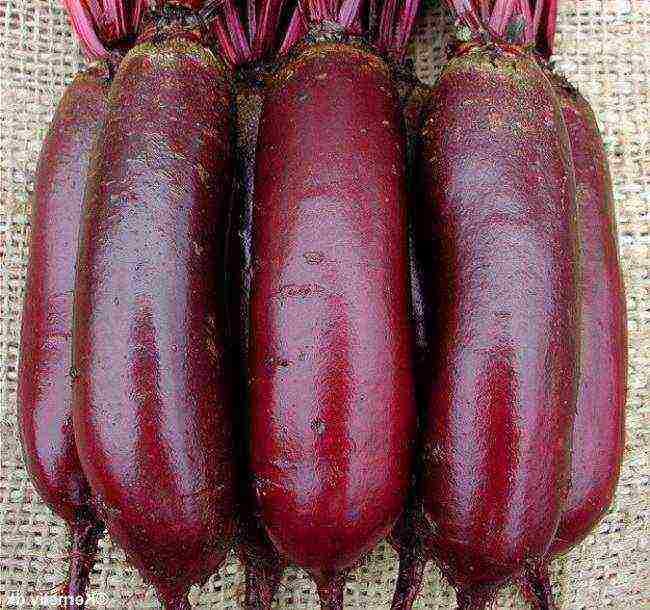
The Cylinder beet variety belongs to the middle late (ripening period - from 120 to 130 days). The shape of the fruit is elongated, cylindrical, diameter - 5-8 cm, length - 10-15 cm. Fruits are medium-sized, with dark skin, weighing 150-250 grams (sometimes more).Cylinder beets are often grown for sales because the roots grow neat, even, and even. Productivity - more than 7 kg per "square", and the "cylinders" are pulled out of the ground very easily.
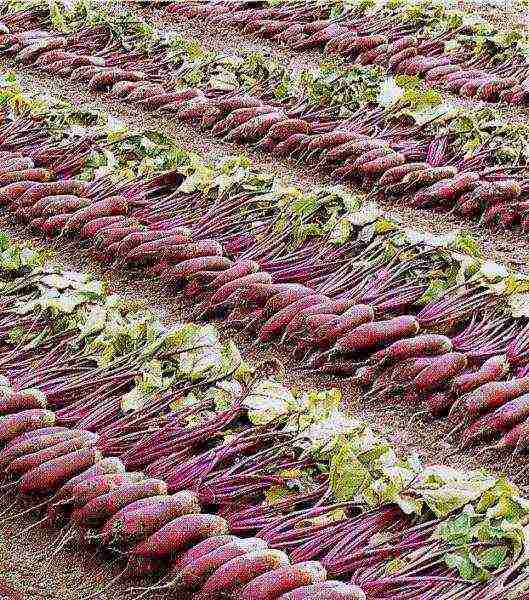
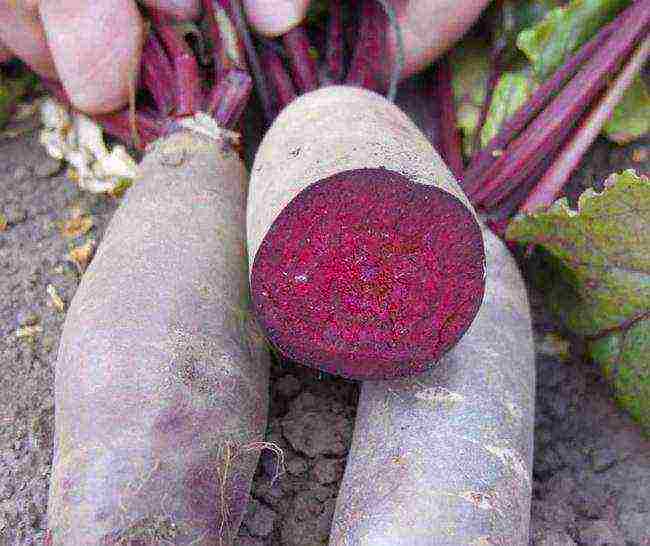
Also in favor of the Cylinder beet is the fact that improved hybrids were developed on its basis - Daughter F1 cylinders and Granddaughter F1.
Beet mulatto
This is a mid-season beet variety (110-120 days), which appeared on store shelves not so long ago, but is already loved by gardeners. The beet variety Mulatto is not very rich in color of the pulp (not burgundy or ruby, namely dark red), but this in no way affects the richness of the taste - it is juicy, sweet, very tasty. After heat treatment, it does not change color, which is important for borscht lovers. Root crops are round, not too large (150-300 grams), smooth. 4-5 kg of mulatto beets are harvested from one "square" of the garden. This variety is suitable for winter storage, resistant to temperature fluctuations, unpretentious to soil, immune to flower beds. Among the disadvantages of mulatto beets is increased demand for lighting; in the shade, the root crop will grow savory and small.
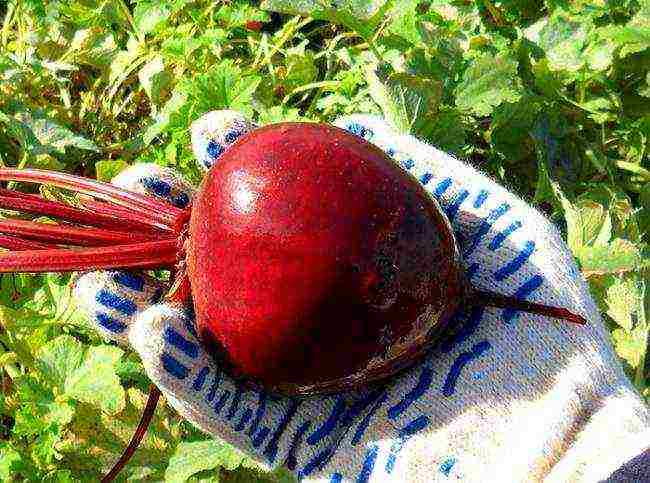
Egyptian flat beet
Bred almost 80 years ago, this beet variety is still popular today, which says a lot. Of course, Egyptian flat beets are not as sweet and tasty as some new varieties (in other words, they taste as usual), they will not last until summer (although 70-80% of root crops will survive the winter), and even to Cercospora, the main enemy of beets, this variety weakly stable. But the Egyptian flat beet also has advantages, thanks to which it still remains among the leaders in the preferences of summer residents: unpretentiousness to soils, the ability to tolerate long periods of drought without damage, and resistance to flowering.
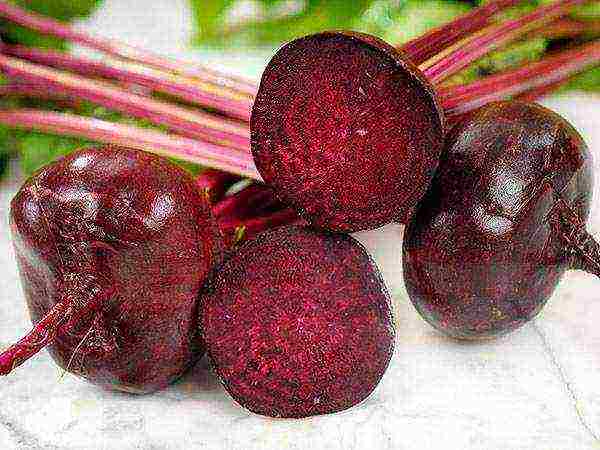
The characteristics of the Egyptian flat beet variety are as follows: the ripening period is 90-100 days (medium early), the root crop grows flattened, small, neat, the average weight is 200-350 grams, but there are specimens up to 500 grams, 4- 8 kg of root crops; the color of the pulp is burgundy-purple, without pronounced rings.
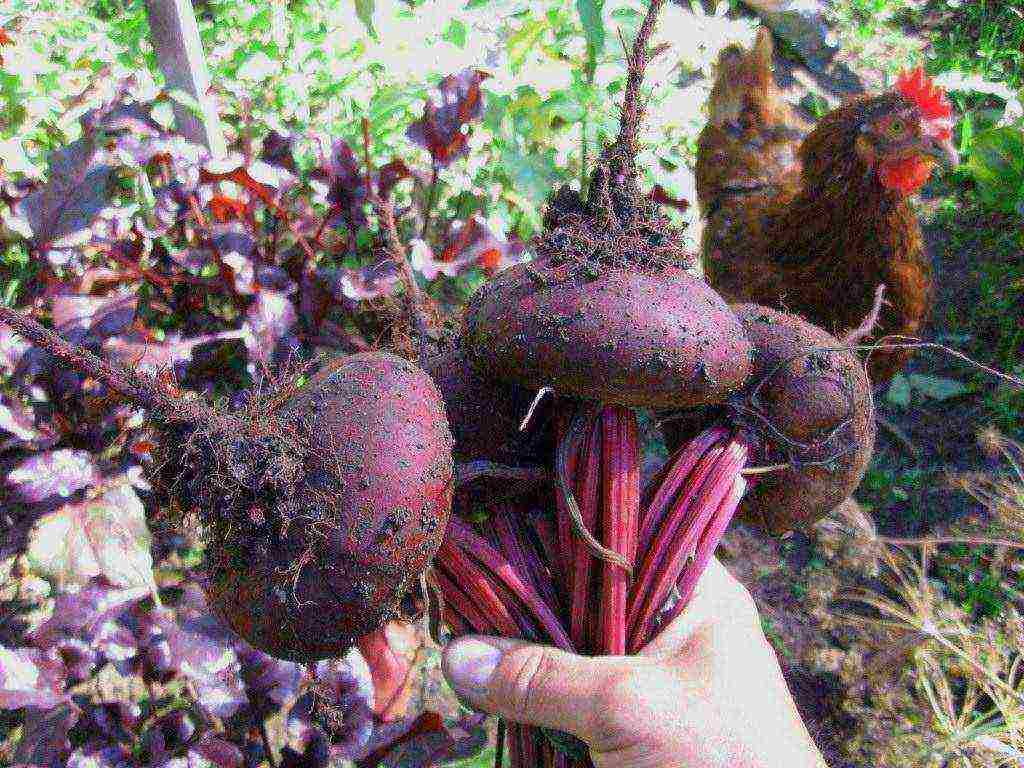
Bordeaux beet 237
Beet variety Bordeaux 237 - another time-tested, reliable, and for many summer residents - the best variety of red beets. Rounded, neat root vegetables with rich burgundy juicy sweet pulp are not too large, so they are convenient to process, bake, Bordov 237 is well suited for salads. The variety is famous for its stable yield, good germination, heat and drought resistance and the ability to store well - until spring, or even until the new season, will lie in the cellar without frowning or shrinking.
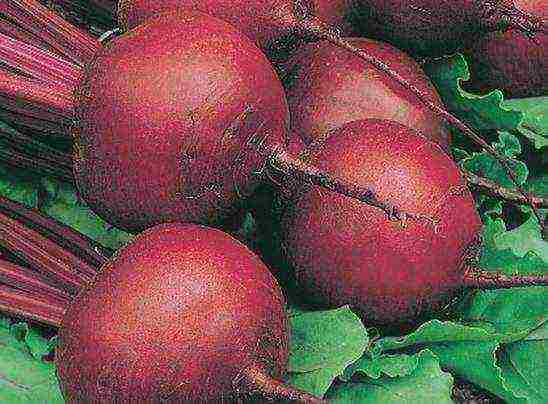
Bordeaux 237 beets are medium early (ripening period - 70-110 days), root crops grow weighing from 200 to 500 grams, with a diameter of 10-15 cm, the shape is round or slightly flattened. The variety is considered resistant to diseases, but in some years it is affected by peronosporosis and cercosporosis. From the "square" of the garden, you can collect from 4 to 8 kg of beets.
Detroit beet
Perhaps the most popular of the early-growing beet varieties today. Still - during the season Detroit can be sown twice, since the ripening period of the root crop is only 650-100 days. Taste qualities beetroot detroit gorgeous - it is juicy, dark red, has a pleasant sweet taste. Root crops grow small (from 100 to 200 grams), but aligned, round, smooth, with a very small axial root - in general, very marketable. Among other advantages of Detroit beets - resistance to flowering, to cold.
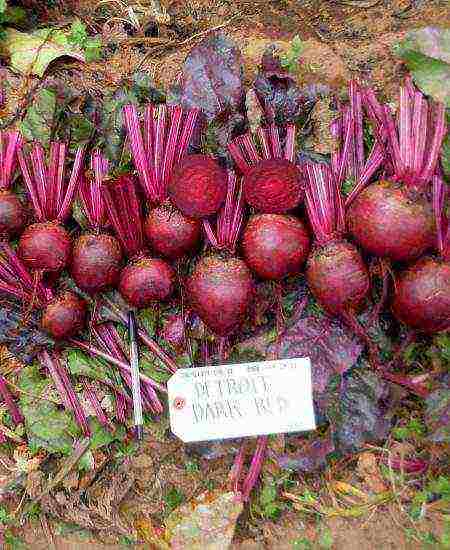
As for early beets, Detroit is stored well, but for laying for a long winter storage, it is still better to choose another variety, mid- or late-ripening. Another unpleasant bonus of this early maturing beet is its weak resistance to diseases, increased demand for watering and light.
Beetroot red ball
It is an early variety with a ripening period of 65-100 days, which is famous for its very juicy, dark red, almost purple sweet flesh, practically without rings on the cut. It is recommended for use in dietary and baby food, and, of course, in cooking (it cooks quickly, but does not have an unpleasant "beetroot" aftertaste). Beet variety Red ball is resistant to cold weather, flowering, stemming, drought and disease resistance - medium. Root crops grow round, weighing 200-500 grams. Productivity of beets Red ball is high, up to 6 kg of root crops are harvested from the "square" of the garden. Stored without problems until spring.
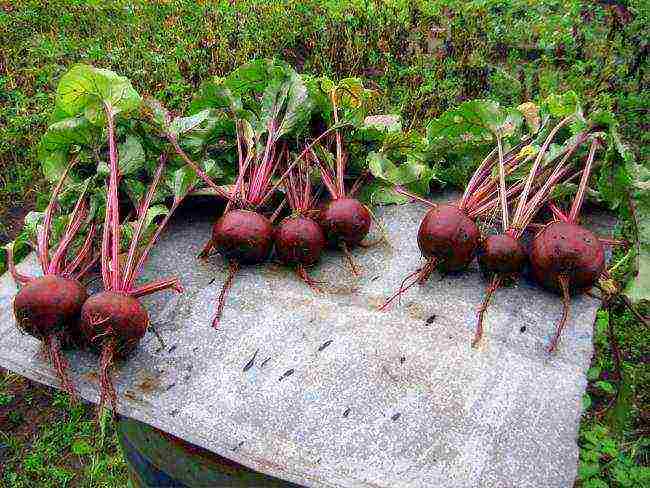
Beet Mona
The mid-late representative of the beet is cylindrical, so in the middle lane it may not have time to ripen. Beet variety Mona good because it is one-sprout (not 3-5 sprouts grow from one seed, but only one), so thinning is not required. As a result, root crops form quickly, grow even and delight with a stable yield. Despite its elongated shape, this beet is easily pulled out of the ground, as it will plunge into the soil only a third of its length. The average weight of Mona beets is 200-350 grams, length is 10-20 cm, diameter is about 5 cm, pulp is tender, juicy, dark red, rings are almost invisible. The yield is high - 6-7 kg of root crops from the "square" of the garden.
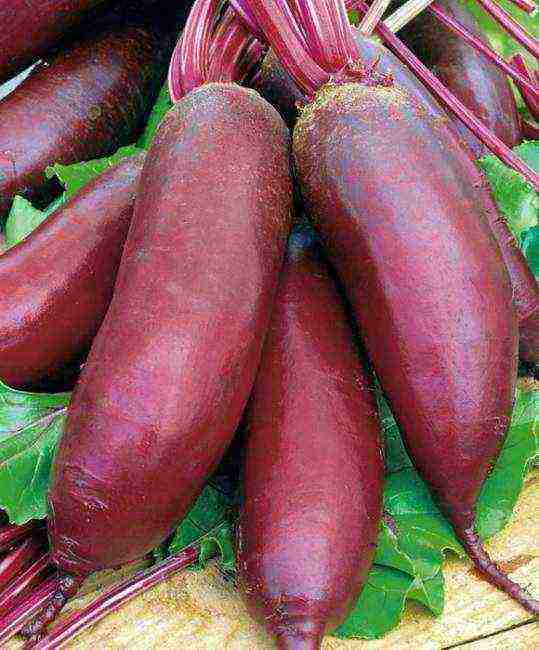
Beet Incomparable
This beet got its name for its excellent taste - its pulp is juicy, very sweet, dark red with almost black rings. Beet variety Incomparable refers to early maturing (70-96 days). Root crops grow round or slightly flattened, weighing 150-400 grams, are stored, despite early maturity, well - until spring. Of the features - incomparable beets do not like heavy soils, are weakly resistant to cercosporosis, resistant to flowering, stemming and cold weather.
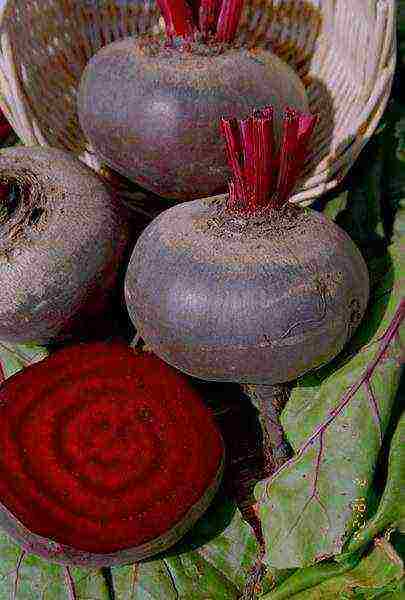
Boltardi beet
An early maturing variety (70-100 days), which, due to its cold resistance, can be sown very early in the open field. Roots beetroot boltardi grow medium-sized (150-350 grams), but very even, smooth, neat rounded shape. The pulp deserves special attention: it is completely ringless, burgundy-purple, very sugary and juicy. Suitable for bookmarking for long-term storage. Boltardi beets are considered resistant to diseases and flowering, but demanding on watering and feeding. From the "square" of the garden, you can collect 3-8 kg of root crops.
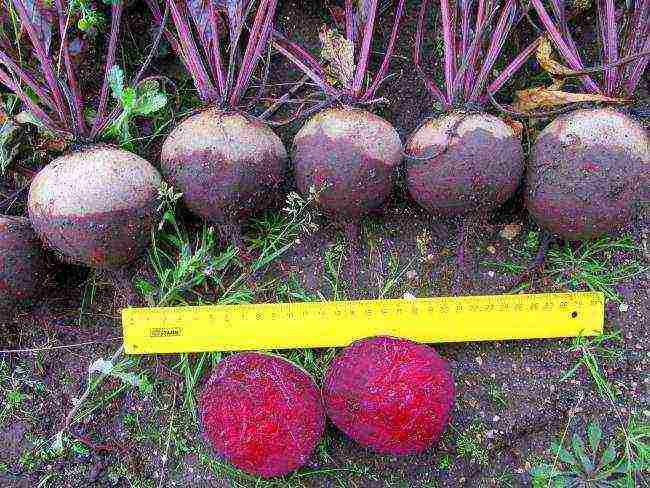
Beetroot bovine blood
This beet variety is for lovers of large root crops: the weight of one specimen can exceed 600 grams. Beetroot bovine blood - a medium late variety (110-120), distinguished by resistance to cold weather, flowering and excellent keeping quality. The beet pulp is dark red, with slightly pronounced rings, but without hard veins; after cooking, the color does not change. In the characteristics of the beet variety, it is indicated that the weight of root crops is 150-240 grams, but in fact, gardeners note that the real weight of Bovine blood is 2 or even three times higher.
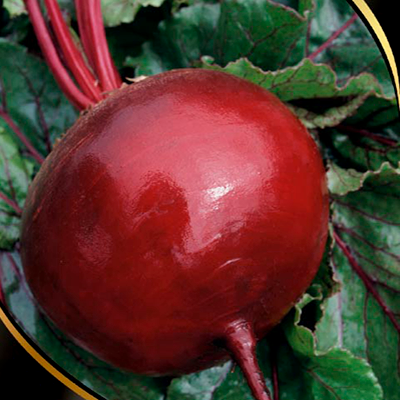
Bona beet
This is a relatively new variety of beets with medium ripening periods (105-120 days), which summer residents fell in love with for their juicy, delicate, sweet pulp taste, small uniform rounded root crops weighing 200-300 grams and good keeping quality. Beet variety Bona pleasant in that it has no rings on the cut and is resistant to most diseases. You can collect 5-7 kg of root crops from the "square" of the garden.
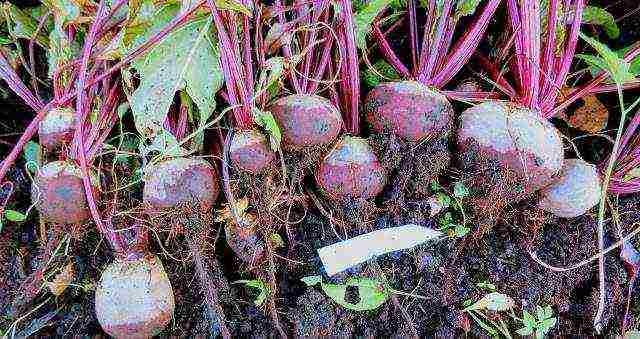
Beetroot
Popularity beet variety Smuglyanka due to its sweet, rich taste, dense pulp of bright pink-purple color and very good keeping quality. Smuglyanka beet belongs to mid-season varieties (95-110 days), root crops grow up to 200-400 grams in weight. Among other advantages of the variety are the stability of yields, cold resistance, resistance to flowering.

Podzimnyaya beet A 474
From the name it is obvious that this is one of the best varieties of beets for winter sowing. Overall beets Podzimnyaya A 474 is a mid-season variety (95-105 days), and is suitable not only for winter sowing, but also for early spring. Differs in dark red flat-rounded roots, growing up to 200-300 grams. Podzimnyaya beet pulp A 474 is sweet, juicy, with a good taste and dark red color. Equally important features of the variety are cold resistance and suitability for long-term storage.
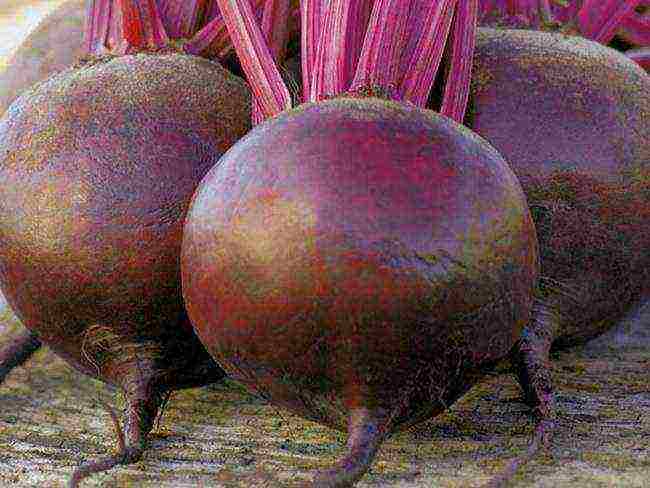
Beet Kestrel F1
One of the main canteen beetroot hybrids for Europe and the USA. Moreover: abroad Kestrel F1 is one of the quality standards and high yield. It is used in baby food and juices, as the rich red color does not "fade" after heat treatment. Same beet hybrid Kestrel F1 possesses excellent commercial qualities - uniformity of root crops, good transportability, high sugar content, keeping quality.
Beet Kestrel F1 belongs to mid-season hybrids (90-100 days) with a small root process, a smooth surface, a small leaf rosette. The average fruit weight is from 300 to 400 grams.
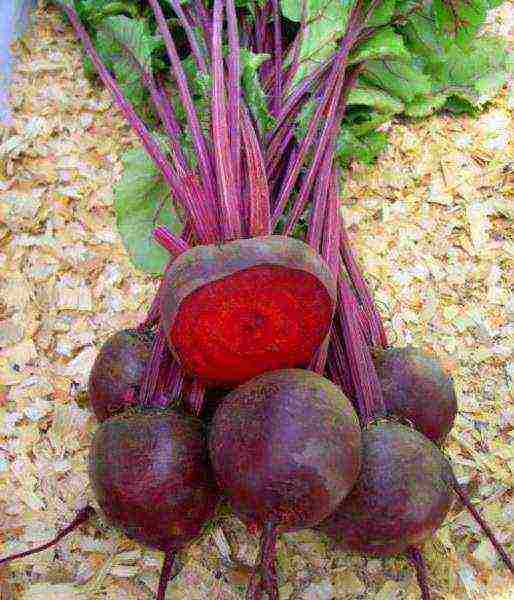
Of course, these are not all the best varieties of table beet. From the early one can distinguish Odnorostkovaya, Libero, Vinaigrette Marmalade, Gribovskaya flat, Crimson, Borshchevaya, Kubanskaya; from mid-season - Bohemia, Negritanka, Tenderness, Opolskaya, Bon-Bon, Larka; from the later ones - Ataman, Torpedo, Renova. This is not to mention hybrids, of which a lot has appeared recently!


